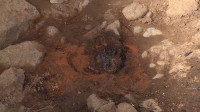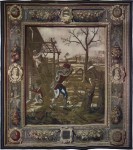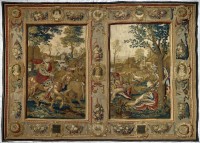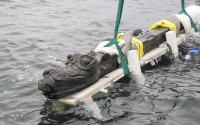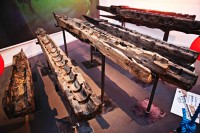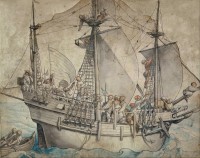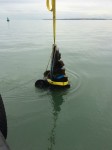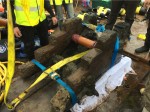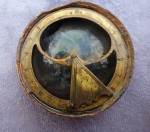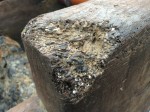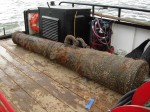 It’s been three years since I first wrote about the rediscovery of the lost silent film The Daughter of Dawn and while there have been some public screenings here and there, the long-awaited DVD and Blu-ray release seemed to be in a holding pattern. I contacted the Oklahoma Historical Society last May asking for an update on the release of the movie and they didn’t know when it would be available. They were in the process of having it rescanned in high definition and it was taking longer than expected. As they recommended, I’ve been keeping an eye on the OHS store where it has yet to appear. It’s not on Amazon, in DVD, Blu-ray or streaming. It’s not on Hulu.
It’s been three years since I first wrote about the rediscovery of the lost silent film The Daughter of Dawn and while there have been some public screenings here and there, the long-awaited DVD and Blu-ray release seemed to be in a holding pattern. I contacted the Oklahoma Historical Society last May asking for an update on the release of the movie and they didn’t know when it would be available. They were in the process of having it rescanned in high definition and it was taking longer than expected. As they recommended, I’ve been keeping an eye on the OHS store where it has yet to appear. It’s not on Amazon, in DVD, Blu-ray or streaming. It’s not on Hulu.
It is, however, suddenly available on Netflix! I don’t know when this happened, but it’s recent, that’s for sure, because I check all the time like a proper nerd. An article this April reported The Daughter of Dawn was being released in DVD and Blu-ray later this year. Milestone Films, the independent distributor of art and classic films that came on board in 2013 to distribute the movie, has an institutional DVD and Blu-ray available on its website for $300 with a home video release scheduled for fall of 2015. I guess Netflix got first crack.
The film is in outstanding condition. It’s complete, no gaps or stills used as placeholders. Some of that is doubtless due to the high definition scanning and restoration, but there are movies this old that have never been lost that are so scratched, speckled and faded they’re hard to watch even after restoration. The five reels of The Daughter of Dawn were kept in a garage for two decades before being given to a private detective in lieu of payment in 2005. We don’t know where they spent the six decades before that, but unless it was a subarctic bunker, it’s beyond belief that the reels survived at all, never mind in such fine fettle. According to Bob Blackburn, executive director of the Oklahoma Historical Society, some parts of the film were in precarious condition, spliced together with masking tape. Milestone Films breaks out the condition issues in more detail in their press release (pdf):
Reel number one felt “tacky,” a symptom of eroding nitrate; reel number two had emulsion damage, from unwanted water or chemical reactions; reel number three was damaged along the edges; reels four and five had sprocket damage, but nothing more.
Watching the movie I only saw maybe two total minutes with significant bubbling around the edges and noticeable damage to the scene, including a handful of frames where for a fraction of a second the very clear outline of a white fingerprint covers the shot (there are several around the 30, 31 minute mark).
Another rare feature of this film is that it’s has a native widescreen aspect ratio. That gives the panoramic shots a grandeur you don’t often see in the ubiquitous 4:3 aspect ratio of the silent movie era. While there appears to have been some cropping of the black borders which doubtless helped achieve this most delightful effect, there is no distortion of the film as shot. It fills up the viewing area of my television perfectly. Such a special treat.
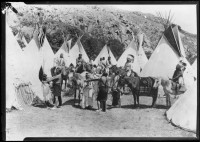 The title cards are sparingly used throughout, but the first few introduce the characters and also name the actors: Chief of the Kiowas played by Chief Chain-To (aka Hunting Horse), Black Wolf played by Sanka Dota (aka Jack Sankadota), Daughter of Dawn played by Princess Peka (aka Esther LeBarre), Big Bear, Chief of the Comanches, played by Chief Cozad (aka Belo Cozad). The romantic lead White Eagle, played by White Parker, son of the famous undefeated Comanche chief, Quanah Parker, does not get one of those title cards, even though a shot of him on a bluff scouting for buffalo opens the movie. A cast listing in the end credits compiled by the researchers working on the restoration of the film notes the tribe of the leads and the names and tribes of everyone else they could identify.
The title cards are sparingly used throughout, but the first few introduce the characters and also name the actors: Chief of the Kiowas played by Chief Chain-To (aka Hunting Horse), Black Wolf played by Sanka Dota (aka Jack Sankadota), Daughter of Dawn played by Princess Peka (aka Esther LeBarre), Big Bear, Chief of the Comanches, played by Chief Cozad (aka Belo Cozad). The romantic lead White Eagle, played by White Parker, son of the famous undefeated Comanche chief, Quanah Parker, does not get one of those title cards, even though a shot of him on a bluff scouting for buffalo opens the movie. A cast listing in the end credits compiled by the researchers working on the restoration of the film notes the tribe of the leads and the names and tribes of everyone else they could identify.
The first Kiowa buffalo hunt (starts around 14 minutes in) requires a hefty amount of suspension of disbelief not to look like a very sad commentary the extermination of the great wild bison herds of the Plains and of the peoples whose livelihoods largely depended upon them. White Eagle spies this thin little herdlet grazing against the majestic backdrop of the Wichita Mountains Wildlife Refuge near Lawton, Oklahoma, and reports back to the chief: “My eye have gladdened at the sight of many buffaloes.” There are, like, 30 max, more than a few of them juveniles. At least they actually lived where they were filmed. Fifteen years earlier there wouldn’t have been any at all to film. They’re transplants, the product of a deliberate attempt by the American Bison Society to return the bison to its ancestral lands. In 1907 the Society secured 15 head of bison from the Bronx Zoo, then under the directorship of bison conservation pioneer William Temple Hornaday, and moved them to the Oklahoma plains. It worked, to a very modest extent, and today there are 650 bison in the Wichita Mountain area descended from those 15. That means the petite herd filmed in 1920 is actually more than double the size it was 13 years earlier, which isn’t bad at all, considering.
There is no actually hunting shown, by the way, just the chase, which is great. The high-speed bareback riding is amazing. That one fellow who falls off his horse after one of the baby bison shoots like a blur in front of him and then chases down his mount to get back on (13:53) is double amazing. Really all of the riding is riveting, even the quotidian stuff. I could watch them get on and off their horses for the whole movie. They just grab a blanket and hop on up.
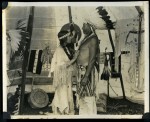 Every skill and craft the Comanche and Kiowa actors brought to the film is showcased beautifully: the clothes, especially the women’s dresses with long knotted fringe, the tipis, the feathered and beaded accessories, shoes, weapons, the dancing (which the Federal government had outlawed by this point but was allowed just for the movie). The famous Tipi with Battle Pictures, home of the Kiowa chief and his daughter, The Daughter of the Dawn, is exquisite, even with its many colors flattened into a sepia tint. Another tipi decorated with paintings of bison with birds standing on their backs makes a lovely showing in the background of several scenes. The interiors of the tipis look fantastic too because you can see the conical sapling structure and the sun illuminating the striations of the textile walls. Also there’s so much space in there!
Every skill and craft the Comanche and Kiowa actors brought to the film is showcased beautifully: the clothes, especially the women’s dresses with long knotted fringe, the tipis, the feathered and beaded accessories, shoes, weapons, the dancing (which the Federal government had outlawed by this point but was allowed just for the movie). The famous Tipi with Battle Pictures, home of the Kiowa chief and his daughter, The Daughter of the Dawn, is exquisite, even with its many colors flattened into a sepia tint. Another tipi decorated with paintings of bison with birds standing on their backs makes a lovely showing in the background of several scenes. The interiors of the tipis look fantastic too because you can see the conical sapling structure and the sun illuminating the striations of the textile walls. Also there’s so much space in there!
The chiefs in particular appear to me to be using hand gestures more than just casually, see for instance starting at 15:35 when the Comanche chief plans their raid on the Kiowas. I wonder if they’re at least in part using the sign language they adopted to communicate with foreigners. An article in The Topeka Daily Capital of May 16th, 1921, reports that Chief Chain-To, in town for the showing of the movie, spoke no English and was converted by a Baptist missionary who had learned their sign language. Obviously they’re talking amongst themselves so there’s no need for them to sign in the film, but maybe it was a performance choice? Like a way to convey information to predominantly Anglo viewers? Or it could have just been a habit, I suppose. Anyway it’s cool.
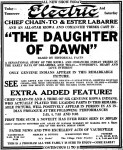 Local newspapers report screenings in small markets around where it was filmed — Tulsa, Oklahoma, Joplin, Missouri, and Topeka, Kansas, for instance — at least one of which (Topeka) was shown by the American Legion. I found one notice of a screening as far afield as Edgefield, South Carolina. It’s interesting that even in March of 1921 the movie was being promoted as historically significant. It got a bit of Bill Cody-style promotion as well. Here’s a notice in the May 19th, 1921, issue of the Joplin Globe:
Local newspapers report screenings in small markets around where it was filmed — Tulsa, Oklahoma, Joplin, Missouri, and Topeka, Kansas, for instance — at least one of which (Topeka) was shown by the American Legion. I found one notice of a screening as far afield as Edgefield, South Carolina. It’s interesting that even in March of 1921 the movie was being promoted as historically significant. It got a bit of Bill Cody-style promotion as well. Here’s a notice in the May 19th, 1921, issue of the Joplin Globe:
Chief Chain-To and five other full-blood Kiowa Indians, including the chief’s grandson, Little Pony, will appear today, Friday and Saturday at the Electric theater in connection with a motion picture, “The Daughter of Dawn,” in which they appear in the cast of characters. The Indians will give exhibition before the screen in Indian dances and songs. Chief Chain-To will give a short lecture in connection with the picture, telling how he likes the “movies” and giving a brief history of the play.
Presumably that lecture, like the one in the Topeka church, would be translated live by an interpreter. I sure would love to know what he said. Alas, if there was any reporting on what he said about how he lives the “movies” and the story behind the film, I haven’t been able to find it.
Final verdict: ten stars. On a scale of four. It’s 80 minutes long, there’s no dialogue, precious little verbiage at all and I couldn’t take my eyes off it. It really is living historic preservation. I’ve already watched it twice and will doubtless add to that count.
[youtube=https://youtu.be/9Hhb9QXxcCM&w=430]

